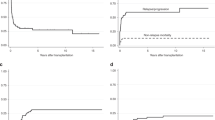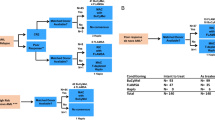Abstract
We studied the long-term outcome of 87 adults with acute leukemia (age 15–59 years at transplant, median 27; 44 myeloid, 42 lymphoblastic, one biphenotypic) who were alive in continuous remission 2 years after a marrow (n = 74) or blood stem cell (n = 13) autograft. Nine relapsed 25–50 months (median 38) after transplantation. Five relapses were straightforward with no karyotypic or morphologic evolution of the original disease. Four recurrences were unusual, with development of myelodysplasia (n = 3) or myeloproliferative disease (n = 1). Five patients died of relapsed disease and four are still alive. Two patients died of complications related to the transplant, and one of ischemic heart disease. Seventy-nine patients (91%) are alive in remission 24–149 months (median 67) after transplantation (75 in continuous remission and four after further therapy) with Karnofsky scores of 80–100% (median 100%). The 8-year probabilities of survival, toxic death, and relapse (from the 2-year mark) are 89%, 3% and 12%. Eleven (12%) survivors had creatinine levels of >110 μmol/l (one more than double), and 14 (16%) had bilirubin levels of >17 mmol/l (one more than double) at the last follow-up. None of the following factors was found to be predictive for survival, non-relapse death, or relapse from the 2-year mark in multivariate analysis: age, sex, type of leukemia, disease stage, diagnosis, conditioning, origin of cells, and nucleated cell dose. We conclude that adult patients with acute leukemia who are alive and well 2 years following an autograft have a high probability of being cured, and the incidence of long-term liver and kidney dysfunction measured by serum bilirubin and creatinine is low.
This is a preview of subscription content, access via your institution
Access options
Subscribe to this journal
Receive 12 print issues and online access
$259.00 per year
only $21.58 per issue
Buy this article
- Purchase on Springer Link
- Instant access to full article PDF
Prices may be subject to local taxes which are calculated during checkout
Similar content being viewed by others
Author information
Authors and Affiliations
Rights and permissions
About this article
Cite this article
Singhal, S., Powles, R., Treleaven, J. et al. Long-term outcome of adult acute leukemia patients who are alive and well 2 years after autologous blood or marrow transplantation. Bone Marrow Transplant 23, 875–879 (1999). https://doi.org/10.1038/sj.bmt.1701744
Received:
Accepted:
Published:
Issue Date:
DOI: https://doi.org/10.1038/sj.bmt.1701744
Keywords
This article is cited by
-
Validation of self-reported complications by bone marrow transplantation survivors
Bone Marrow Transplantation (2000)



